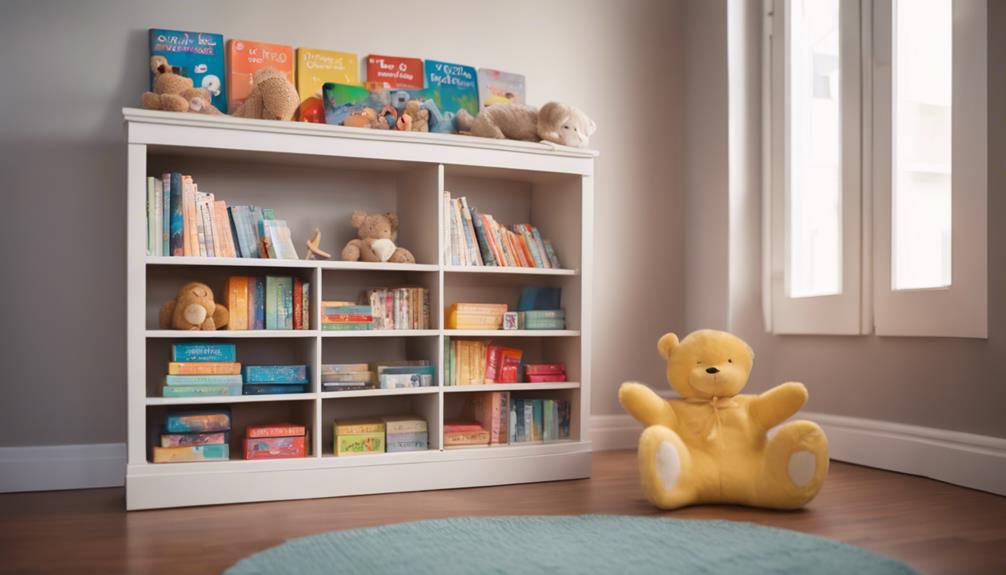When reading to your baby, choose colorful books with high-contrast images and interactive features. Make sure to have books easily accessible in different rooms, at their eye level, and switch them out regularly to create a cozy reading corner. Establish a daily routine for bonding, improving language skills, and nurturing a love for reading. Connect with your baby by asking questions, encouraging brain development, and creating strong relationships. Interactive reading is beneficial for visual and cognitive growth, while introducing books early on enhances vocabulary and listening abilities. Promote language development by using varied intonations and a rich vocabulary. Consider using interactive books or engaging storytelling techniques to further involve your baby. There are more valuable insights waiting for you on your parenting journey ahead.
Key Takeaways
- Choose books with vibrant illustrations to capture your baby's attention.
- Opt for interactive features like lift-the-flap or touch-and-feel books.
- Make reading a daily routine to build a strong bond and enhance language development.
- Engage your baby through questions, sounds, and pointing to images while reading.
- Create a cozy reading nook with books at your baby's eye level for easy access.
Importance of Reading to Babies
Reading to your baby is essential for their early development and sets the foundation for a lifelong love of books. The importance of reading to babies can't be emphasized enough, especially regarding language development and early literacy. By exposing your baby to reading at a young age, you're helping to shape their communication skills even before they can speak.
This early exposure aids in developing listening skills, stimulating brain growth, and enhancing their vocabulary. Research shows that the more words a baby hears, the more words they'll learn over time, contributing greatly to language acquisition and cognitive development.
Moreover, reading to your baby creates a strong parent-child bond, providing comfort, security, and fostering positive interactions. This shared activity not only benefits your baby's development but also strengthens the emotional connection between you and your little one.
Embrace the importance of reading to your baby as an essential step in nurturing their growth and love for learning.
Choosing Baby-Friendly Books

When selecting baby-friendly books, opt for those with vibrant, eye-catching illustrations that captivate your little one's interest.
Look for books with high-contrast images, as they're easier for young babies to see and engage with.
Consider interactive features like textures, flaps, or sound effects to enhance your baby's sensory experience during storytime.
Age-Appropriate Book Selection
Selecting baby-friendly books involves choosing materials with bold illustrations and high-contrast images to engage your baby's visual senses effectively. Opt for age-appropriate board books with sturdy cardboard pages that are easy for little hands to manipulate. These books often feature high-contrast pictures that are visually stimulating for infants and support their early visual development.
The use of interactive features like lift-the-flap or touch-and-feel elements can enhance your baby's engagement with the story and promote tactile exploration.
When selecting books for your baby, consider options made of cloth, soft plastic, or board material for their durability and safety. These materials are ideal for babies who tend to explore books with their mouths. Accessible books with tactile components not only encourage interaction but also help babies develop their fine motor skills.
Interactive Book Features
Interactive features in baby-friendly books play an essential role in engaging your little one and enhancing their early reading experience.
When reading to babies, opt for books with bright, bold illustrations to captivate their attention and support their early visual development. High-contrast images are particularly beneficial for young babies as they're easier to see and interact with.
To promote tactile exploration, choose books made of cloth, soft plastic, or sturdy board materials that are safe for babies to handle. Sturdy cardboard pages enable babies to turn and interact with the book independently, fostering a sense of autonomy and engagement.
Additionally, ensuring that books are easily accessible and within your baby's reach can encourage early interaction with reading materials.
Making Books Accessible

To guarantee easy access to books for your baby, keep them in various rooms around your home where you both spend time. Place books in book baskets or on shelves at your child's eye level to make them easily accessible for little hands to explore. Rotating the selection regularly can help maintain your baby's interest in different stories and illustrations. Consider creating a cozy reading nook with a comfortable chair, soft pillows, and good lighting to make reading time inviting and enjoyable for both you and your baby.
Using book storage solutions that allow books to be displayed with covers facing out can help your baby select books independently. This setup not only makes books accessible but also encourages your baby to engage with them actively.
Daily Reading Routine

Establishing a daily reading routine with your baby is key to building a strong bond and enhancing their language development. By engaging with books regularly, you help your baby learn and build their vocabulary, setting the foundation for robust pre-literacy skills.
Consistency in reading sessions not only aids in cognitive development but also nurtures emotional intelligence. This daily ritual provides a calming and nurturing environment for you and your baby to connect and learn together.
Through a structured reading routine, you create a sense of predictability and security for your child, fostering a love for books and storytelling from an early age. The repeated exposure to language and narratives during these sessions can have a significant impact on your baby's literacy skills, paving the way for a lifelong appreciation for reading.
Engaging With Baby Through Reading

Engage with your baby through reading to strengthen your bond and support their development. Reading to babies not only builds your baby's listening skills but also stimulates brain development.
During reading sessions, help your baby explore books through their senses. Point to pictures in the book and ask simple questions to encourage interaction. For example, you can ask your toddler, 'What color is this?' or 'Can you find the puppy in the picture?'
Encouraging your baby to participate by turning pages or labeling objects can make reading more engaging for them. This interaction fosters a deeper connection between you and your little one.
Age-Appropriate Reading Tips

When selecting books for your baby, opt for ones that are tailored to their age to guarantee they're engaging and beneficial.
Engage your baby's senses by choosing books with high-contrast images and interactive elements.
Make the reading experience interactive by encouraging your baby to participate in labeling objects or turning pages to enhance their engagement.
Choose Right Books
Selecting age-appropriate books is vital when reading to your baby to promote engagement and learning. For infants, opt for board books with simple stories and colorful illustrations to capture their attention.
Babies aged 6-12 months tend to enjoy books with interactive features like flaps or different textures to stimulate their senses. When reading to toddlers aged 12-18 months, choose books with repetitive phrases and engaging pictures to encourage language development.
As your toddler grows to be 18-24 months old, consider longer stories with complex plots and humor to keep them interested.
Matching the book to your baby's developmental stage and interests is essential in fostering a love for reading. By exposing them to a variety of age-appropriate books, you can help enhance their cognitive abilities and language skills.
Remember to explore different genres and styles to see what resonates best with your little one.
Engage Baby's Senses
To captivate your baby's interest during reading sessions, consider choosing books that offer a variety of textures, colors, and interactive features. Engaging your baby's senses through touch and exploration is vital for their development. Opt for books with high-contrast images and simple illustrations, particularly suitable for newborns to stimulate their visual senses effectively. Board books with sturdy pages are ideal as they're easy for babies to handle and explore, promoting interactive engagement.
Encouraging touch and exploration can be achieved by selecting cloth or soft plastic books that allow your baby to interact physically with the reading material. Additionally, choosing books with bright and bold illustrations can capture your baby's attention and foster their visual development. These visual stimuli not only entertain your baby but also play an essential role in their cognitive growth.
Make It Interactive
Engage your child in interactive reading sessions to enhance their learning experience and foster a love for books. To make reading to your baby more interactive, consider incorporating elements that engage their senses and encourage interaction. For babies aged 3 to 6 months, using board books with textures and interactive features can captivate their attention and stimulate their developing senses. As your baby grows older, around 6 to 12 months, point out objects in the books, encourage them to touch and feel different textures, and involve them more in the story by asking simple questions.
For toddlers, interactive reading sessions play an important role in bridging the gap between spoken and written words. Discussing the story, naming objects, and asking questions can greatly enhance their comprehension and vocabulary. Don't hesitate to bring the story to life by using funny voices, gestures, and other interactive elements to create a fun and engaging reading experience for your toddler.
| Age Range | Interactive Reading Tips |
|---|---|
| 3-6 months | Use board books with textures and interactive features to engage senses. |
| 6-12 months | Point out objects, encourage touch, and involve babies more in the story. |
| Toddlers | Discuss the story, name objects, ask questions, and use funny voices. |
Benefits of Early Reading

Reading to your baby early on provides numerous benefits that contribute to their language development and future literacy skills. Here are some key advantages of starting early:
- Strong Parent-Child Bond:
Reading to your baby from a young age not only enhances their language skills but also fosters a strong emotional connection between you and your little one.
- Brain Development:
Early exposure to reading is important as it stimulates brain development, helping your baby develop listening skills and lay the foundation for future cognitive abilities.
- Vocabulary Enhancement:
The more words your baby hears during reading sessions, the more words they'll learn over time. This process enhances their vocabulary and boosts their pre-literacy skills.
- Success in Reading:
Engaging with your baby through reading aids in building essential language and literacy skills, which are necessary for successful reading and comprehension later in life.
Encouraging Language Development

Encouraging your baby's language development through interactive reading sessions is essential for their early communication skills and future literacy abilities. When you read aloud to your baby, you're exposing them to a rich tapestry of vocabulary and sounds, laying a strong foundation for their language development.
Engaging in conversations while reading not only enhances their vocabulary but also nurtures their communication skills. Babies benefit greatly from hearing varied intonations and speech patterns during these reading sessions, helping them grasp the nuances of language.
Encouraging your baby to make vocalizations and respond to stories further aids in their language development, fostering their ability to express themselves effectively. Research shows that regular reading to babies can have a significant impact on their future language acquisition and literacy skills.
Fun and Interactive Reading Ideas

To make reading sessions more enjoyable and interactive for your baby, consider incorporating fun elements that engage their senses and imagination.
Here are some ideas to enhance your storytelling experience:
- Explore Interactive Books: Incorporate lift-the-flap books or touch-and-feel books to captivate your baby's attention and make reading a hands-on experience.
- Get Creative with Storytelling: Use puppets, funny voices, or sound effects to bring characters to life and make the story more engaging for your little one.
- Encourage Active Participation: Prompt your baby to turn pages, point to pictures, or make sounds while you read to foster their engagement and interaction with the story.
- Introduce Rhymes and Repetition: Choose books with rhymes, repetition, or interactive features to keep your baby entertained and involved in the reading process.
Frequently Asked Questions
What Age Should You Start Reading to Your Baby?
Start reading to your baby as soon as possible to promote language development and cognitive benefits. Beginning in early months, reading fosters emotional and developmental growth. Make it a routine for a positive reading relationship.
What Is the Best Advice You Can Give to New Parents?
Reading to your baby from birth can increase their vocabulary by up to 1,000 words by age 3. It's essential for bonding, language skills, and brain development. Choose engaging books for a great start.
When Should You Start Reading to Your Baby in the Womb?
You should start reading to your baby in the womb around 18 weeks. Hearing your voice early on can help them recognize you and get familiar with language. It's a great way to bond and lay the foundation for literacy.
What Is the Hardest Month of the Baby's First Year?
The toughest month of your baby's first year is typically the fourth. Sleep disruptions, growth spurts, and newfound independence can make this period challenging. Your little one's increased awareness and stronger emotions add to the complexity.
Conclusion
In the journey of parenthood, reading to your baby is a simple yet powerful way to foster early language development and create lasting bonds.
By choosing baby-friendly books, establishing a daily reading routine, and engaging with your little one through storytelling, you're laying the foundation for a lifelong love of reading.
So, take the time to read to your baby each day, and watch as they grow and thrive in the world of words.










